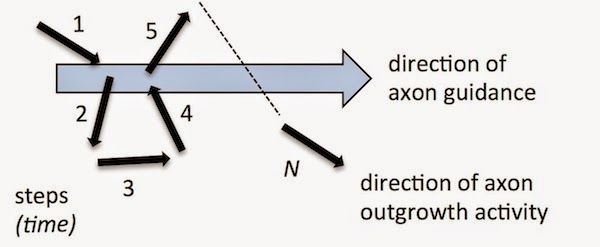An axon is attracted towards its target by guidance cues. A moth flies towards the source of a pheromone. A spider is sucked across the floor towards the nozzle of a vacuum cleaner. Is the attraction of an axon towards its target more like the movement of the moth or the spider?
 |
| credit: pmillera4 |
The attraction of the axon is like the attraction of a moth.
 |
| Credit: internetarchivebookimages |
In the 1990s, the first molecule that had the properties of a chemoattractant was discovered. The discovery was based on several different findings. Mutations in the unc-6 gene had been shown to disrupt axon guidance in the nematode Caenorhabditis elegans. A postdoctoral fellow (me!) in the laboratory of Dr. Edward Hedgecock at Johns Hopkins University sequenced the unc-6 gene. The sequence indicated that the UNC-6 molecule was likely a secreted protein, which suggested that it might act as an extracellular signal to guide axons in vivo. Meanwhile, Dr. Marc Tessier-Lavigne’s laboratory at the University of California at San Francisco biochemically isolated from a vertebrate animal a protein that had chemotropic properties. When presented to isolated neurons, the axons would grow towards the source of the protein. They found that this protein, Netrin, was homologous to UNC-6. When this work was published it made quite a splash. As the New York Times reported, finding a chemical signal that could guide axons was a kind of Holy Grail for neuroscientists. The discovery was hailed as “one of the most important and exciting discoveries in modern neuroscience”.
At the molecular level, the attraction of the axon to the netrin molecule is like the attraction of a moth to the pheromone molecule. The axon senses the netrin molecule and intracellular changes cause the axon to extend towards the site where the axon's receptor bound the extracellular guidance cue.
Or is the attraction of the axon like a spider being sucked into a vacuum cleaner?
 |
| Credit: davefeatherston |
It can be imagined like this:
Here an "attractant" guidance cue might increase the probability of axon outgrowth towards the source of the cue, but not cause the axon to be directed towards the source of the cue. For example, in the illustration below three different cues set a probability for axon outgrowth in each direction. The directional bias created by these cues can be visualized by using the probability distribution to create a simple random walk. That is, at each step of the random walk there is a 0.3 probability of the outgrowth going left, a 0.4 probability of the outgrowth going down, and a 0.3 probability of the outgrowth going right. Overtime the directional bias created by the cue is down. If the blue cue is removed the directional bias will shift left. Although at the molecular level the blue cue causes outgrowth towards the source of the cue, the cue is actually required for guidance that is perpendicular to the source of the cue.
 |
| On the left is illustrated the effects that three extracellular cues (blue, red, and green arrows) have on the probability of axon outgrowth. On the right are plotted 10 simulated random walks based on these probabilities. Because of the random walk response, at the macroscopic level of guidance the directional response to a guidance cue is variable and depends on how all the cues regulate the probabilities of outgrowth. Importantly, to understand guidance it might be necessary to consider that cues do not act as attractants. Like the air is to the spider, the guidance cues do not necessarily cause attractive guidance. References: Angier, N. (August 16, 1994) Finding Elusive Factors That Help Wire Up Brain, The New York Times. Yang, Y., Lee, W., Tang, X., & Wadsworth, W. (2014). Extracellular Matrix Regulates UNC-6 (Netrin) Axon Guidance by Controlling the Direction of Intracellular UNC-40 (DCC) Outgrowth Activity PLoS ONE, 9 (5) DOI: 10.1371/journal.pone.0097258 Xu, Z., Li, H., & Wadsworth, W. (2009). The Roles of Multiple UNC-40 (DCC) Receptor-Mediated Signals in Determining Neuronal Asymmetry Induced by the UNC-6 (Netrin) Ligand Genetics, 183 (3), 941-949 DOI: 10.1534/genetics.109.108654 |

No comments:
Post a Comment